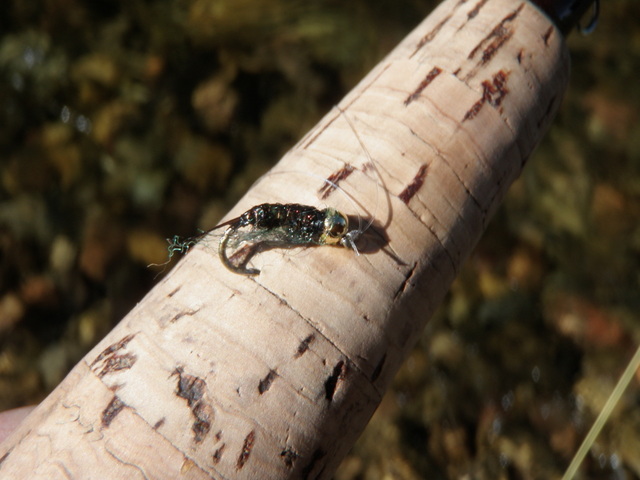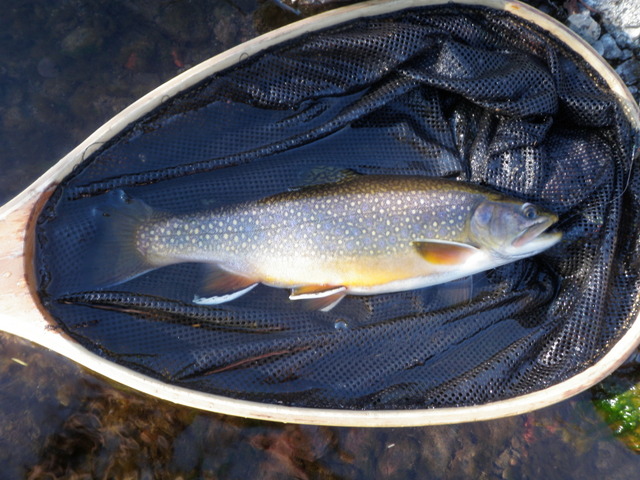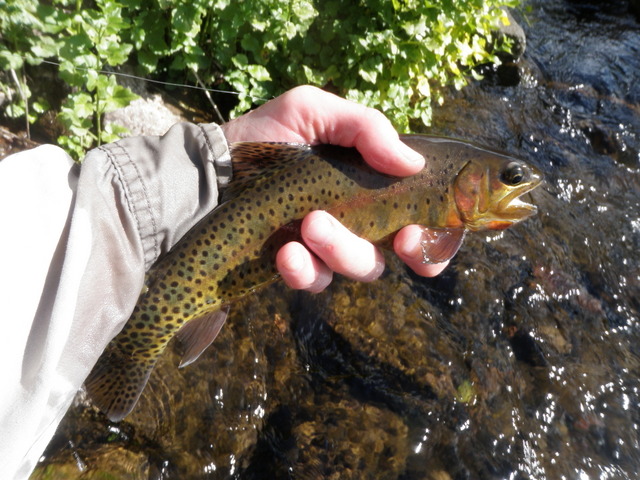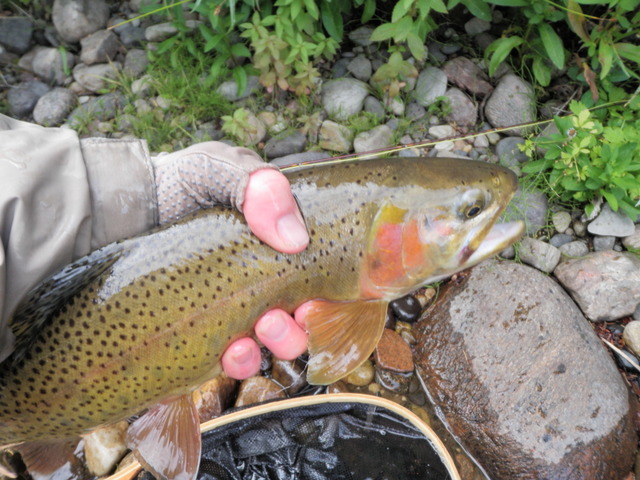Time: 10:30AM – 6:00PM
Location: 40 minute hike from trailhead; just above a narrow chute area with tall vertical walls and whitewater.
Fish Landed: 24
South Fork of the White River 09/18/2014 Photo Album
In September 2013 I visited the Flattops Wilderness and spent a day on the South Fork of the White River. I spent a full day on the beautiful clear backcountry stream and landed seven fish with all but one on the small side. In 2014 I spent two days on the North Fork above Himes Peak Campground and enjoyed some wonderful fishing, but I was in need of a change. Did I want to commit another day to the South Fork? Another option might be to fish the upper North Fork below Trappers Lake and even combine that with some fishing on Trappers Lake. Since the weather was supposed to be clear and warm again on Thursday, I decided to give the South Fork another try. In 2014, however, I decided to hike even further than my last venture so that I would begin above the stretch of water characterized by high vertical rock walls and deep pools.
Part of the attraction of the South Fork is the fact that it flows for over forty miles through national forest and wilderness area, and the river is relatively large over most of the drainage allowing for open space for backcasting and wading. Most headwater streams in national forest lands are small and necessitate casting in tight quarters and difficult wading over deadfalls and through dense brush.
I executed my plan flawlessly and after a vigorous forty minute hike, I arrived at a position just above the narrow stretch with vertical rock walls where the trail dropped very close to the river. It was 10:30, and the sky was bright blue, the air temperature was around 50 degrees, and it was clear that Thursday would be a warm late September day in this remote area of the Flattops Wilderness. The water was higher than a year ago due to the heavy rain on Monday and Tuesday September 8-9, and it was crashing through the narrow canyon chute at a rapid clip. I brought my Sage four weight and began my day with a purchased stimulator with a peach colored body.
Despite my optimism I fished for fifteen minutes without any sign of a fish, so I converted to a yellow Charlie Boy hopper with a beadhead hares ear and copper john. This move paid off somewhat as I tallied a nine inch rainbow in a small deep hole where a side channel entered the main river. I continued working my way upstream rapidly, as I encountered quite a few wide shallow riffle areas that I simply waded through. In the first hour of fishing I added a couple more small rainbows plus a foul hooked fish and a momentary hook up. I decided to break for lunch early as the fishing was relatively slow, and as I munched my sandwich, I had visions of a repeat of my 2013 experience. I was having difficulty identifying holding water in this clear backcountry river.
After lunch and a continued lack of success, I decided to exchange the yellow Charlie Boy for a tan version, and then I removed the copper john and replaced it with a beadhead pheasant tail nymph. Only the hares ear remained on my line from the morning. This change improved my success rate a bit, but the air temperature was now heating up rapidly, and I was feeling quite sluggish in the bright sunny conditions. If I was sluggish, wouldn’t a coldwater fish feel the same way?
At some point during this early afternoon period while reconfiguring, I dropped the hares ear nymph in the water, so I elected to replace it with an ultra zug bug as I desired more flash in a subsurface attractor. The ultra zug bug is a Scott Sanchez creation that is actually a stripped down version of a prince nymph sans hackle and white wings. By 3PM I began noticing tiny blue winged olive mayflies drifting up slowly from the surface of the river, and my catch rate seemed to improve during this time as fish began to grab the pheasant tail even though I don’t typically view this size 18 fly as a good imitation of BWO nymphs. I’m guessing the BWO emergence caused the fish to become active feeders, and they were not particularly selective about what subsurface food morsel they ate.
Concurrent with the increased insect activity I continued wading upstream and the river narrowed a bit thus creating more deeper pockets and attractive holding areas for trout. The combination of increased insect activity, better holding water and more distance from the trailhead seemed to combine to improve my action and this in turn improved my confidence and focus. Also during this period I went through a stretch of water where I landed three or four brook trout, although only two made my six inch cut off for registering on the fish counter.
Unfortunately the blue winged olive hatch waned, and I entered a another slow period when I decided to abandon the three fly system and reverted to a size 12 stimulator with a light olive body. This did nothing for my success rate, although I enjoyed making some great fluttering casts to some nice pocket water for twenty minutes.
By 4:30 the sun sank lower in the western sky, and parts of the river were enveloped in shade. Following a fly from sun to shade and back to sun is always a difficult task, and I debated quitting and getting a jump on my return hike. However, I remembered that some of my best fishing took place in the late afternoon on Tuesday and Wednesday as the air temperature cooled, so perhaps the same might apply to the South Fork. I resolved to stick it out this time to see what developed.
The lengthening shadows and cooler temperatures caused the caddis to become active, and numerous small tan insects dapped and skittered on the surface along with the occasional lagging blue winged olive. I decided that I should return to nymphs in case the fish became active subsurface feeders again as they had earlier in the afternoon, so I tied on a Chernobyl ant with striped legs and a large visible neon yellow indicator. This would help me follow my flies in the shadows and sun glare. Below the Chernobyl I attached an ultra zug bug, and then on the point I knotted a classic beadhead prince nymph.
This combination caught fire over the remainder of the afternoon as I landed ten additional fish before quiting at 6PM. This was truly my type of fishing as I moved rapidly from pocket to pocket making three to five casts, and more often than not I was rewarded with a dip of the Chernobyl and a feisty streaking fish that inhaled the ultra zug bug or prince. The decision to continue fishing into the early evening was rewarded.
Near the beginning of the late afternoon productive period, I tossed the Chernobyl and nymphs into the nook of an eddy where the water returned from its swirl to a current break. The Chernobyl disappeared, and I instantly set the hook thus provoking a huge rainbow to streak across the river. This fish looked like a giant in this stretch of water that consistently produced twelve inch rainbows. I gave the fish line and allowed it to run, but after a twenty foot highlight reel, the flies popped free, and I was quite disappointed.
I probably hooked but did not land at least ten additional fish during the last one and a half hours, and some of these fish were quite nice and probably measured thirteen to fourteen inches. The rainbows of the South Fork seemed comparatively powerful for their size, and that may partly explain my higher than normal ratio of lost fish. I also had a difficult time maintaining side pressure because the fish tended to run in a circle around my position, and there were numerous branches and bushes along the bank that interfered with my attempts to reach the rod sideways. Another reason may have been the tendency of the rainbows to attack the middle fly of my trio, and I’ve historically noticed that more fish seem to escape from the middle fly position.
By the late afternoon I discovered the most productive water types. The first and best water consisted of long riffle sections with four feet of depth, and these areas produced fish at the tail in front of current breaks and along the outer seams. The water needed to be four feet or greater in depth, however, as shallow riffles seemed to be void of fish. Deep pockets also produced, but again these needed to be substantial, and this is defined as five to ten feet long and four feet or greater in depth. Even better was a deep pocket or slot that met these dimensions, but bordered on one side by a bank or structure.
Overall it was a decent day and my best day ever on the South Fork. I landed three or four nice rainbows in the thirteen inch range and the bulk of my catch was nine to ten inch fish. Had I landed the big one or a few more of the late afternoon escapees, my rating would improve from decent to outstanding. Regardless of fishing success, the South Fork is a gorgeous remote setting deep in the Flattops Wilderness and worth visiting for that reason alone.
I began my return hike at 6PM, and I clocked twenty minutes until I reached my entry point in the morning. I estimate that I covered one mile of water over the course of the day, and when combined with the two mile inbound hike, means that I was three miles from the trailhead at my farthest point. It was a fun day.





























































